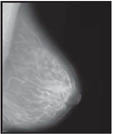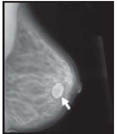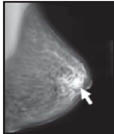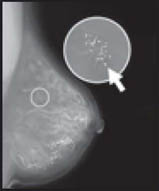|
Finding Breast Changes
Mammograms
Getting Your Mammogram Results
What a Mammogram Can Show
Lumps (or "mass")
Calcifications
Are Mammogram Results Always Right?
Changes That Need More Follow-Up
There are two ways to find breast changes:
- Clinical breast exams--a breast exam done by your health care provider
-
Mammograms
--an
x-ray
of your breasts
One way to find breast changes is with a clinical breast exam done by your health care provider. He or she will check your breasts and underarms for any lumps, nipple discharge, or other possible changes. This breast exam should be part of a routine medical check-up.
The best tool for finding breast cancer is a mammogram. A mammogram is a picture of the breast that is made by using low-dose x-rays. It is currently recommended that women over age 40 receive a mammogram every 1 to 2 years.
Some women check their own breasts for changes. If you find a change, it's important to call your health care provider for an appointment. Make sure to watch the change you found until you see your provider. But a breast self-exam and a clinical breast exam are not substitutes for mammograms.
|
Questions to ask your health care provider about a breast change
|
- How can I tell the difference between my usual lumps and
lumps I need to do something about?
- How will you be able to tell what kind of breast change I have?
- What should we do to watch this change over time?
|
Mammograms are used for both
screening
and
diagnosis.
A
screening mammogram
is used to find breast changes in women who have no signs of breast cancer. Most women get two x-rays of each breast.
If your recent screening mammogram revealed a breast change
since your last one, or if you or your health care provider
noticed a change, he or she will probably recommend a
diagnostic mammogram.
More x-rays are taken during a diagnostic mammogram than a screening mammogram to get clearer, more detailed pictures of the breast. It is also used to rule out other breast problems.
| Tip
|
|
Take your original mammogram and
copy of the medical report with you if you change doctors
or centers or need a second opinion.
|
A
digital mammogram
is another way to take a picture of your breasts. The procedure for having a digital mammogram is the same as a screening mammogram, except that it records the x-ray images in computer code instead of on x-ray film.

It is important to see your doctor and get a mammogram
every 1 to 2 years after age 40 to find breast changes.
Here are mammograms of three different women. Doctors look at these x-rays for any breast changes that don't look normal.

Normal |

Benign Cyst
(Not Cancer)
|

Cancer
|
| Mammograms and Breast Implants
|
|
When you go for your mammogram, tell staff if you have
breast implant.
A
technologist who is trained in x-raying patients with implants will do your mammogram. Breast implants can hide some breast tissue and make it harder to read your mammograms.
If you got implants for cosmetic reasons:
- You still need to get screening mammograms, with extra pictures to help get an accurate reading.
If you got an implant after having a
mastectomy
for breast cancer:
- You should continue to get mammograms of your other breast. Ask your doctor if you still need mammograms of the breast with the implant.
|
Ask your doctor when you will get your results. You should get a written report of your mammogram results within 30 days of getting the x-ray. This is the law. Be sure the mammogram facility has your current address.
If your results were normal, it means the
radiologist
did not find anything that needs follow-up.
If your results were abnormal, it means the radiologist found:
- A change from a past mammogram
- A change that needs more follow-up
The radiologist will look at your x-rays for breast changes that do not look normal. The doctor will look for differences between your breasts. He or she will compare your past mammograms with your most recent one to check for changes. The doctor will also look for lumps and
calcifications.
The size, shape, and edges of a lump sometimes can give doctors more information about whether or not it is cancer. On a mammogram, a growth that is benign often looks smooth and round with a clear, defined edge. On the other hand, breast cancer often has a jagged outline and an irregular shape. (See
Chart 1: Possible Mammogram Results and Follow-Up Care.)
A calcification is a deposit of the mineral
calcium
in the breast tissue. Calcifications appear as small white spots on a mammogram. There are two types:
Depending on how many calcium specks you have, how big they are, and what they look like, your doctor may suggest that you:
- Have a different type of mammogram that allows the radiologist to have a closer look at the area
- Have another screening mammogram, usually within 6 months
- Have a test called a
biopsy.
| Calcium in the diet does not
create calcium deposits (calcifications) in the breats. |
 |
Calcification |
|
 |
"I used to think
whenever a mammogram found
a lump or a mass,
it was probably cancer--it turns out that most
breast changes are not cancer.
That's one thing I sure didn't mind being wrong about."
Anne, Age 60 |
|
No. Although they are not perfect, mammograms are the best method to find breast changes. If your mammogram shows a breast change, sometimes other tests are needed to better understand it. Even if the doctor sees something on the mammogram, it does not mean it is cancer.
Sometimes your doctor needs more information about a change on your mammogram. Your doctor may do follow-up tests such as an
ultrasound
or more mammograms. The only way to find out if an abnormal result is cancer is to do a biopsy. It is important to know that most abnormal findings are not cancer.
 Back to Top Back to Top
< Previous Section | Next Section > |